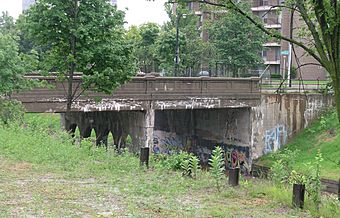Chestnut Street Bridge (Detroit) facts for kids
Quick facts for kids |
|
|
Chestnut Street Bridge-Grand Trunk Railroad
|
|

Chestnut Street bridge from the northeast
|
|
| Location | Detroit, Michigan |
|---|---|
| Built | 1929 |
| Architect | Grand Trunk Western Railroad |
| MPS | Highway Highway Bridges of Michigan MPS |
| NRHP reference No. | 00000115 |
| Added to NRHP | February 18, 2000 |
The Chestnut Street Bridge is a special bridge in Detroit, Michigan. It goes over a path called the Dequindre Cut, which used to be a busy train track. This bridge was added to a list of important historical places, called the National Register of Historic Places, in the year 2000.
Contents
Bridge History
By the 1920s, Detroit was a very busy city. More than 400 factories were operating on the east side of the city. However, getting around was hard. The city's streets were not well planned. Also, many large factories were growing. A huge network of train tracks crisscrossed the city. All these things made traffic very slow, especially when trying to go east or west.
Solving Traffic Problems
To fix the traffic jams, the city of Detroit and the Grand Trunk railroad made a plan in 1923. They decided to build 22 "grade separations." This means they would build bridges or tunnels to separate roads from train tracks. This way, cars and trains would not have to stop for each other. Both the city and the railroad agreed to share the costs of this big project.
One of the main train lines needing these changes ran along a path now known as the "Dequindre Cut." These tracks started in the northwest and went southeast. They connected to many other train lines. They also supplied materials to large factories near the river. Some of these factories included the Detroit-Michigan Stove Plant and the Parke-Davis Laboratories. The tracks ended at the Brush Street Depot in downtown Detroit.
Building the Bridge
By March 1930, 16 of the new crossings over the Dequindre Cut were finished. The Chestnut Street Bridge was one of these completed bridges. The nearby Antietam Avenue Bridge was also finished soon after. In 1964, the Antietam Avenue Bridge and the Chestnut Street Bridge were used together. They became a one-way pair, helping traffic flow better.
In the 1980s, the train tracks were no longer used. The ownership of the land changed. As of 2008, the Dequindre Cut is being transformed. It is becoming a popular "rail trail" for walking and biking.
Bridge Design
The Chestnut Street Bridge crosses over the Dequindre Cut. It is built using two strong steel beams, each 31 feet long. These beams rest on concrete supports and a concrete center pier. The steel beams are covered in concrete for protection.
The bridge has a wide concrete deck, about 50.3 feet across. This deck is covered with asphalt, creating a 30-foot-wide roadway for cars. The sides of the bridge have solid concrete railings. These railings have eight recessed panels, arranged in pairs. There are also five concrete posts along the railings. A wooden light pole is placed at each end of the sidewalk on the bridge.
Why the Bridge is Important
The Chestnut Street Bridge is in good condition today. When you look at the bridge, you can clearly see how the Dequindre Cut runs below it. You can also see how it fits into the city's street layout. This bridge is a great example of the big effort made in the early 1900s. It shows how cities worked to separate roads and train tracks to improve traffic and safety.

